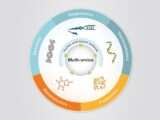
Exploring Molecular Biology Across Diverse Omics in Multi-Omics Approaches
December 27, 2023In the realm of biological studies, the multi-omics approach stands out as a powerful methodology that harnesses data from a spectrum of omics methods—ranging from genomics and transcriptomics to proteomics, epigenomics, and metabolomics. This approach unfolds as a mosaic of complementary insights, delving deeper into biological complexities. By amalgamating these diverse datasets, a more focused set of results emerges, unveiling potential biomarker signatures that transcend the limitations of individual omics datasets.
Increasingly, the multi-omics approach finds application in fundamental cellular biology studies, disease comprehension, and the identification and validation of drug targets. At the heart of various omics methods lies a common thread: molecular biology.
Unveiling the Diversity of Molecular Read-Outs through Multi-Omics Approaches Multi-omics is often referred to by different names, such as pan-omics, integrative omics, trans-omics, and vertical omics. The comprehensive analysis involves exploring genomes, proteomes, transcriptomes, epigenomes, and metabolomes, as outlined in Table 1.
| Multi-omic approach | Molecular read-out | Results | Technology |
|---|---|---|---|
| Genomics | Genes (DNA) | Genetic variants, gene presence or absence, genome structure | sequencing, exome sequencing |
| Epigenomics | Modifications of DNA | Location, type, or degree of reversible DNA modifications | Modification-sensitive PCR and qPCR, next-generation sequencing, mass spectrometry |
| Transcriptomics | RNA and/or cDNA | Gene expression, gene presence or absence, splice sites, RNA editing sites | RT-PCR (reverse transcription-PCR) and RT-qPCR, gene arrays, RNA-sequencing |
| Proteomics | Protein | Abundance of peptides, peptide modifications, and interactions between peptides | Mass spectrometry, western blotting, and ELISA |
| Metabolomics | Metabolites | Abundance of small molecules such as carbohydrates, amino acids, and fatty acids | Mass spectrometry, nuclear magnetic resonance (NMR) spectroscopy, and HPLC |
These investigations systematically delve into the layers of molecular biology’s central dogma, traversing from the fundamental genetic code (DNA) to RNA, proteins, and the inclusion of metabolites. Consequently, multi-omics studies offer a comprehensive depiction of the ongoing processes and the current state within the body or even within a singular cell.
While amalgamating outputs from various omics disciplines such as genomics, transcriptomics, and proteomics allows for a holistic examination of the biological landscape, the sheer volume of data often poses challenges in deciphering and deriving conclusive insights. In a singular omics dataset, correlations are typically established instead of definitive conclusions, as establishing causality from individual omics datasets proves intricate. Single omics outcomes provide glimpses of the overall biological panorama but lack illumination on the upstream origins or downstream consequences of those states.
The amalgamation of multiple omics datasets serves to present a more encompassing perspective, enabling the extraction of specific conclusions and the identification of causative changes. This, in turn, unveils the etiology of diseases and potential targets for treatment. Adopting a multi-layered approach—comparing datasets and identifying shared outcomes—multi-omics strategies provide insights that surpass the capabilities of single-omic approaches alone. Diverse fields, including oncology, Alzheimer’s disease research, drug discovery, cellular biology, and infectious disease research, have all witnessed significant benefits from the adoption of a multi-omics framework.
Given the evident advantages of scrutinizing multiple omics datasets over singular omics, the adoption of multi-omics approaches is experiencing a notable surge. Over the past 11 years, the count of multi-omic-related publications on PubMed has seen a remarkable increase from 7 to 2,195, indicating a robust compound annual growth rate (CAGR) of 69%. Consequently, the prevalence of these approaches in research studies is anticipated to rise further, with molecular biology remaining foundational to the success of multi-omics.
The evolution of multi-omics research and its trending applications The growing popularity of multi-omics approaches in comprehending biological processes is fueled by recent advancements in accessibility. Foundational methods, particularly molecular biology and next-generation sequencing (NGS), are becoming more approachable, commonplace, and cost-effective. Moreover, the improvement and increased accessibility of analytical tools for interpreting vast relational datasets contribute to the rise of multi-omics. The role of data sharing is pivotal, with research groups making results publicly available, enabling any laboratory to access omics data that would have otherwise been out of reach.
An intriguing facet of multi-omics lies in its application to enhance understanding at new levels of cellular biology, disease, and drug discovery. It is making notable contributions in diverse research areas, leading to discoveries that would have eluded detection within a single omics dataset.
Fields witnessing groundbreaking findings through multi-omics approaches include:
1. Oncology:
- Uncovering significant contributors to colon and rectal cancer through the integration of proteomic, genomic, and transcriptomic data. [1]
- Identifying a potential therapeutic target for colon cancer by leveraging genomics, proteomics, and transcriptomics data. [2]
2. Alzheimer’s Disease:
- Proposing distinctions between genetic predisposition and environmental contributions to Alzheimer’s disease through the integration of transcriptomic, epigenomic, and genomic data. [3]
3. Drug Discovery:
- Assisting in the identification and verification of drug targets, a crucial step in understanding the mechanism of action in drug discovery. [4]
4. Cellular Biology:
- Enhancing our understanding of basic cellular biology by discovering an entirely new cell type through the REAP-seq technique, which enables the measurement of RNA and protein expression at a single-cell level. [5]
- Revealing insights into the immune response to COVID-19 infection and identifying potential therapeutic targets by combining transcriptomics, proteomics, and antigen receptor analyses. [6]
A noteworthy aspect is that many of these multi-omics studies relied on molecular biology techniques such as PCR and qPCR.
How Molecular Biology Techniques Support Multi-Omics Applications
The intricate layers of multi-omics technologies revolve around the detection and quantification of nucleic acids. Genomics, epigenomics, and transcriptomics, all integral components of multi-omics, rely on nucleic acid-based methods that delve into the realms of DNA and RNA. As a result, molecular biology techniques and tools emerge as foundational elements in the realm of multi-omics.
Next-generation sequencing (NGS), a widely employed technique offering powerful discovery capabilities, operates on a hypothesis-free principle for detection and quantification. Fundamentally, polymerase chain reaction (PCR) and quantitative PCR (qPCR) play crucial roles in genomics, epigenomics, and transcriptomics. These methods seamlessly integrate basic PCR and qPCR steps, often complemented by reverse transcription PCR (RT-PCR). Additionally, PCR, qPCR, and RT-PCR present accessible and cost-effective alternatives to NGS, with even NGS methods relying on PCR for library preparation.
At the core of genomics lies the analysis, detection, and quantification of DNA through PCR and qPCR. This necessitates the utilization of molecular biology tools such as DNA polymerases, deoxyribonucleotide triphosphates (dNTPs), master mixes, oligonucleotide primers, and more.
Epigenomics techniques, involving DNA sequencing, demand specialized PCR and qPCR enzymes that can be either methylation-sensitive or insensitive. The creation of controls and standards in these methods, achieved through the methylation of nucleic acids, requires DNA polymerases and modifying enzymes capable of methylation and demethylation (methyltransferase and epigenetic products).
In the realm of transcriptomics, which revolves around gene expression analysis, RT-PCR and qPCR are indispensable. The process entails reverse transcription facilitated by reverse transcriptases, followed by the utilization of DNA polymerase and other essential PCR reagents.

Nucleic acid-based omics methods represent a significant portion of the inputs to multi-omics. While all nucleic acid-based omics are based on fundamental molecular biology methods, each provides a unique dimension to the overall multi-omic understanding for specific applications.
Table 2. Molecular biology techniques are crucial for several layers of a multi-omics approach.
| Molecular biology technique | Multi-omics approaches | Tools |
|---|---|---|
| PCR | Genomics, Epigenomics, Transcriptomics | DNA polymerases Reverse transcriptases PCR kits and master mixes RT-PCR kits Oligos/primers dNTPs Buffers Thermal cyclers PCR plastics |
| Modify DNA and PCR requiring enzymes that are methylation sensitive | Genomics, Epigenomics, Transcriptomics | FastDigest enzymes Conventional restriction enzymes Restriction enzyme buffers DNA Polymerases RNA Polymerases Ligases RNase Inhibitors Phosphatases & Kinases Ribonucleases (RNases) Deoxyribonucleases (DNases) Thermal cyclers PCR plastics |
| RT and RT-PCR | Transcriptomics | PCR kits and master mixes Reverse transcriptases DNA polymerases dNTPs Oligos/primers Buffers cDNA synthesis kits and master mixes Thermal cyclers PCR plastics |
| Electrophoresis (endpoint PCR detection and for preparatory methods) | Genomics, Epigenomics, Transcriptomics (analysis of RNA and DNA fragment size) | Electrophoresis system DNA and RNA stains and ladders |
Some multi-omic analysis techniques diverge from nucleic acids-based methods and tools. For example, proteomics relies on protein-specific approaches like mass spectrometry, western blotting, and enzyme-linked immunosorbent assay (ELISA). Similarly, metabolomics employs methods such as mass spectrometry, nuclear magnetic resonance (NMR) spectroscopy, and high-performance liquid chromatography (HPLC) for the analysis of small molecules.
The adoption of a multi-omics strategy to unravel complex biological processes is evidently growing and is poised to remain a favored approach. The potential showcased by these omics techniques, particularly when amalgamated, has led to groundbreaking discoveries in both basic and applied research across diverse fields, including oncology, infectious diseases, neurology, cell biology, and drug discovery. Significantly, the efficacy of these techniques relies on fundamental molecular biology skills, techniques, and tools. Throughout various steps in multi-omics techniques such as genomics, epigenomics, and transcriptomics, essential molecular biology components like PCR, DNA modification, and electrophoresis play pivotal roles.
In the application of these techniques, and any molecular biology-dependent endeavor, the use of reliable, high-quality, and high-purity reagents is paramount. Opting for products that are user-friendly and ensure consistent results in the foundational steps empowers researchers to concentrate on the advanced applications and advancements within their respective fields.

















